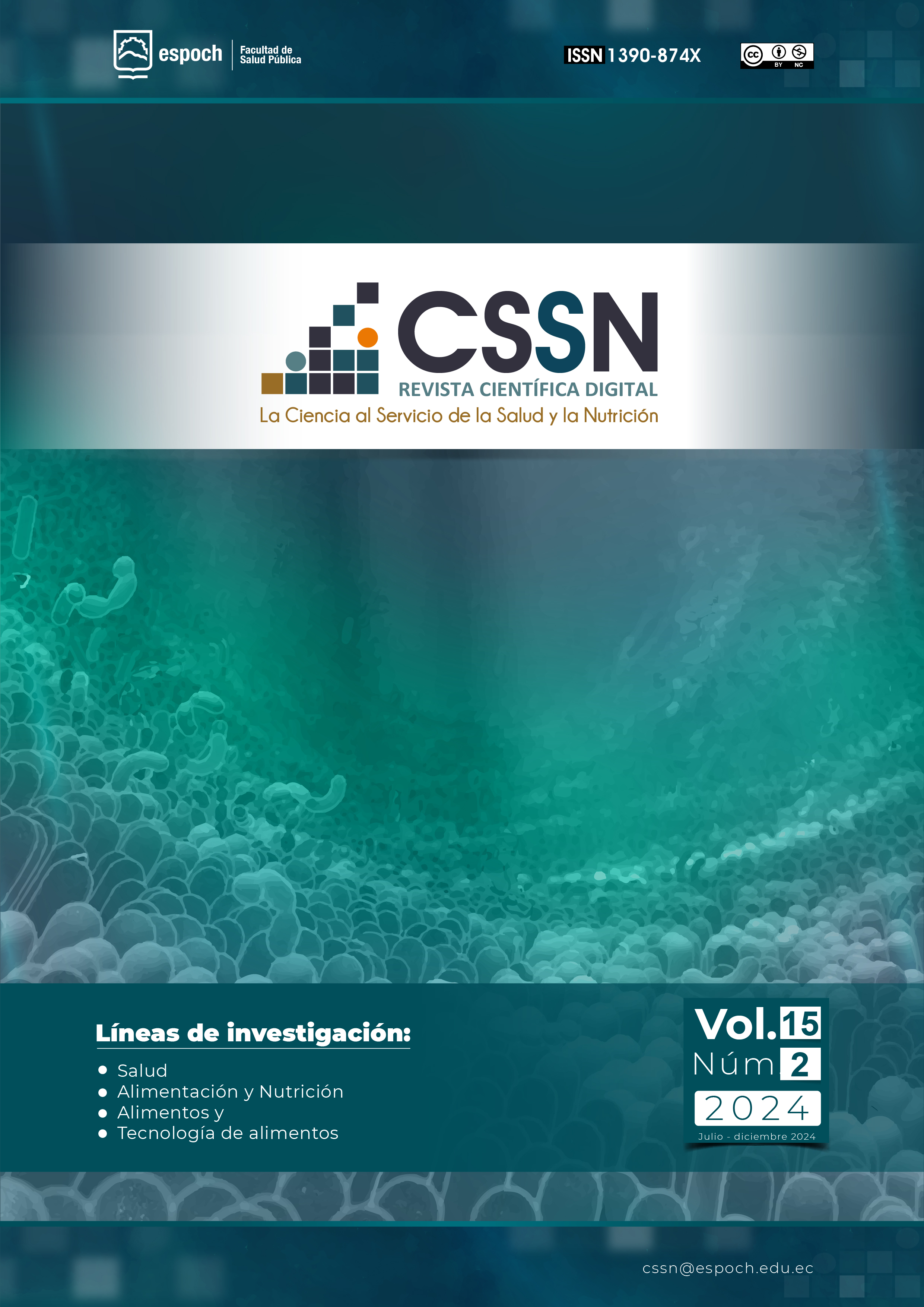Phase angle characterization in diabetic patients
DOI:
https://doi.org/10.47187/cssn.Vol15.Iss2.355Keywords:
phase angle, electrical bioimpedance, diabetes mellitus, muscle mass, visceral fat, adipose tissue, metabolic complicationsAbstract
Introduction: The characterization of the phase angle, measured by electrical bioimpedance, is a key clinical marker in patients with diabetes mellitus, muscle mass, adipose tissue and visceral fat; it allows its analysis as a factor of direct relationship with tissue and cellular response. Objective: The present study has been devised to apply descriptive statistics, which are to be segmented according to sex and age, with a view to obtaining interval-type control points on the phase angle in correlation with metabolic complications. Methodology: A crosssectional study design was employed, incorporating both a Pearson correlational analysis and a principal component analysis. The objective of this analysis was to evaluate the relationship between phase angle and body composition as well as metabolic complications associated with type 2 diabetes mellitus. Results: 121 patients with type 2 diabetes mellitus were evaluated by descriptive analysis and variance using the Kolmogorov-Smirnov test, considering the components of the phase angle in arms, legs and trunk, broken down by sex. Discussion: In
this study, the relationship between phase angle and metabolic complications in patients with type 2 diabetes mellitus was evaluated. A phase angle control interval between 5 and 7 points was established; values below 5 were associated with inflammatory syndromes and metabolic complications. Conclusions: The phase angle is positioned as a key indicator for the identification and management of metabolic complications in type 2 diabetes mellitus.
Downloads
References
Mattiello R, Amaral MA, Mundstock E, Zatti H, Oliveira A, Machado AS, et al. Association between phase angle from bioelectrical impedance analysis and level of physical activity: systematic review and meta-analysis. Clin Nutr ESPEN. 2020;35:29-37.
Martins PC, Pereira AF, Sanches AF, Silva JC, Barreto MA, Nunes HC, et al. Phase angle as a marker for sarcopenia and functional capacity in cancer patients. Clin Nutr ESPEN. 2021;43:198-203.
da Silva BA, Matos RA, do Nascimento MZ, Vannucchi H, Jordao AA. Association between phase angle and complications in critically ill surgical patients. Clin Nutr ESPEN. 2021;45:268-75.
Souza NC, Chagas DC, Rocha SS, Pinheiro MM, da Costa EP, Leite ID, et al. Association of phase angle with health-related quality of life in hemodialysis patients. J Ren Nutr. 2016;26(2):76-80.
Fernandes SA, Copetti M, Rabito EI, da Silva DM, Trindade E, Falcão RC. Phase angle is associated with risk of malnutrition and nutritional status in hospitalized patients. Clin Nutr ESPEN. 2020;37:179-83.
Gonzalez MC, Barbosa-Silva TG, Bielemann RM, Gallagher D, Heymsfield SB. Phase angle and its determinants in healthy subjects: influence of body composition. Am J Clin Nutr. 2016;103(3):712-6.
Mattiello R, Amaral MA, Mundstock E, Zatti H, Machado AS, Almeida LB, et al. Phase angle predicts mortality in critically ill patients: a systematic review and meta-analysis. Crit Care. 2021;25(1):1-12.
Pillar N, Singer P. Phase angle in intensive care: prognostic utility and perspectives in clinical practice. Nutrition. 2020;78:110819.
Lukaski HC. Evolution of bioimpedance: a circuitous journey from estimation of physiological function to assessment of body composition and return to clinical research. Eur J Clin Nutr. 2022;76(3):319-25.
Ríos-Campuzano M, Pinzón-Cancino HA, Uscátegui-Lopera OJ, Escobar-Jaramillo SE. Bioelectrical impedance vector analysis and phase angle as indicators of functional capacity in older adults. J Geriatr Phys Ther. 2021;44(4):204-12.
Castizo-Olier J, Irurtia A, Jemni M, Carrasco-Marginet M, Fernández-García R, Rodríguez FA. Bioelectrical impedance vector analysis in athletes and physically active populations: a systematic review and future perspectives. PLoS One. 2022;17(5)
Dias KA, Soares D, Pessoa IB, Lima RM. Phase angle as a predictor of muscle strength and function in elderly: a systematic review and meta-analysis. Exp Gerontol. 2022;163:111794.
Mattiello R, Oliveira A, Manta AB, et al. Bioelectrical impedance-derived phase angle as a predictor of frailty in older adults: a systematic review and meta-analysis. Ageing Res Rev. 2023;85:101793.
Mazidi M, Karimi E, Rezaie P, Kengne AP. Phase angle and clinical outcomes: a systematic review and meta-analysis of observational studies. Arch Gerontol Geriatr. 2020;90:104108.
Szulc P, Duboeuf F, Marchand F, Chapurlat R. Phase angle as a marker of musculoskeletal health in older men. J Gerontol A Biol Sci Med Sci. 2022;77(9):1923-30.
Fukuda Y, Fukuda H, Mine T, Nakamura T. Phase angle as a marker of sarcopenia in patients with cirrhosis: a systematic review and meta-analysis. Hepatol Res. 2020;50(10):1192-1200.
Sabatino A, Regolisti G, Cosola C, Pecorini C, Naldi A, Fiaccadori E. Phase angle predicts mortality and hospitalization in hemodialysis patients. J Ren Nutr. 2022;32(6):713-20.
Mendes J, Silva FS, Oliveira JM, et al. Phase angle predicts length of stay and mortality in hospitalized patients with COVID-19: a multicenter prospective study. Clin Nutr ESPEN. 2022;48:460-7.
Garlini LM, Alberti LR, et al. Bioelectrical impedance analysis-derived phase angle in the assessment of nutrition status in heart failure patients. Nutrition. 2021;85:111136.
Santoso B, Pudjiadi AH, et al. Phase angle as a predictor of post-surgical complications in gastrointestinal cancer patients: a prospective study. J Gastrointest Surg. 2022;26(3):631-41.
Chen L-K, Woo J, Assantachai P, et al. Phase angle in Asian older adults: a critical review. Aging Dis. 2023;14(2):1056-71.
Ríos-Campuzano M, Espinosa-Coronel E, Escobar-Jaramillo SE. Bioelectrical impedance analysis for predicting complications in diabetic patients: a review of recent studies. Front Endocrinol. 2023;14:785-90.
Zhou S, Zhu H, Huang S, et al. The association between bioelectrical impedance analysis-derived phase angle and cognitive impairment in older adults: a cross-sectional study. Clin Nutr ESPEN. 2021;44:83-90.
Da Silva BAH, Vaz de Melo D. Phase angle and body composition alterations in patients undergoing dialysis: insights from bioelectrical impedance analysis. Renal Nutr. 2023; 39(3):115-25.
Gao H, Liu D, Huang L. Phase angle as a predictor of disease severity in COVID-19 patients: a prospective cohort study. Clin Nutr ESPEN. 2023;49:22-9.
Wang B, Sun Y, Zhang Z, Wang Q, Liang L, Dong X, et al. Association between phase angle and diabetic peripheral neuropathy in Type 2 diabetes patients. Endocrine. 2024; Available from: https://doi.org/10.1007/s12020-024-03689-4
Published
How to Cite
Issue
Section
License
Copyright (c) 2025 LA CIENCIA AL SERVICIO DE LA SALUD Y NUTRICIÓN

This work is licensed under a Creative Commons Attribution-NonCommercial 4.0 International License.




